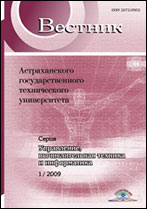|
This article is cited in 1 scientific paper (total in 1 paper)
TELECOMMUNICATION SYSTEMS AND NETWORK TECHNOLOGIES
Application of random forest method for evaluating info-communication system elements
A. A. Oleinikov
Astrakhan State Technical University,
Astrakhan, Russian Federation
Abstract:
Today the process of making decision on upgrading the network infrastructure of information and communication systems requires the participation of competent staff able to evaluate the state of element both by technical parameters and by social-economic factors expressed in quantitative and qualitative way. The aim of the work is to improve the means of summarizing expert information for classifying situations related to the operation of the network infrastructure of the information and communication system. The random forest method is suggested to lay into the ground of the theoretical base. The possibility of applying the method of grouping decision trees to select the most appropriate option in the process of forming recommendations on the modernization of information and communication system elements has been considered. The methods of lowering the level of retraining groups of trees are studied; According to the analysis results, the automation of building multi-element structures and groups of decision trees is proposed, which makes it possible to increase the efficiency of using this mathematical apparatus for processing heterogeneous information. There has been found the possibility of using multi-element structures, decision trees, for classifying the elements of infocommunication systems and reducing the negative impact of retraining by organizing separate trees into groups called decision forest. The information sources for forming train and test samples are identified, which allows creating the element base classifiers for information transmission systems. The problem solved in the present work gives the possibility to reduce the negative impact of the human factor expressed in making wrong decisions due to a lack of basic data and low competencies. The positive aspects of generalization of expert information associated with the accumulation of experience of qualified personnel are enhanced by generalizing knowledge through the use of artificial intelligence methods that process retrospective and current information about the state of equipment. The implementation of a decision support system for the formation of recommendations during the operation of information and communication systems can improve the accuracy of decision making over a given time interval.
Keywords:
infocommunication systems, network element, decision tree, decision-making forest, retraining, retrospective information.
Received: 31.01.2019
Citation:
A. A. Oleinikov, “Application of random forest method for evaluating info-communication system elements”, Vestn. Astrakhan State Technical Univ. Ser. Management, Computer Sciences and Informatics, 2019, no. 2, 56–65
Linking options:
https://www.mathnet.ru/eng/vagtu578 https://www.mathnet.ru/eng/vagtu/y2019/i2/p56
|

| Statistics & downloads: |
| Abstract page: | 121 | | Full-text PDF : | 45 | | References: | 18 |
|




 Contact us:
Contact us: Terms of Use
Terms of Use
 Registration to the website
Registration to the website Logotypes
Logotypes








 Citation in format
Citation in format 
